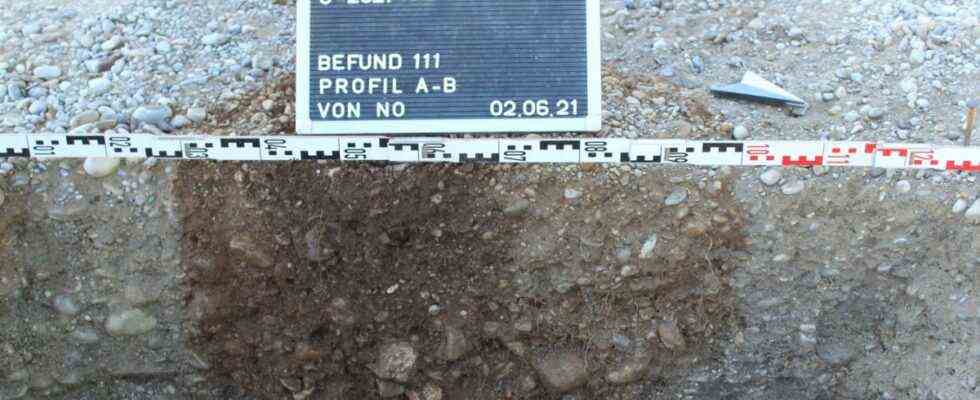More than 2000 years ago, the area of today’s Kirchheim seems to have been a good place to live: archaeologists repeatedly unearth traces of prehistoric settlements when they examine the earth for hidden treasures before starting major construction work. In the summer of 2019, for example, evidence of a large settlement from the Latène Age, an epoch of the younger Iron Age, was found on the area where the new grammar school is currently being built. Excavations are now under way on the grounds of the State Garden Show 2024.
A dark spot in the earth on the State Garden Show grounds shows that a post has been rammed into the ground here.
(Photo: 3archaeologist)
So far, the archaeologists have not discovered a spectacular individual find, as stated in a press release from Kirchheim 2024 GmbH. Overall, the density of findings in the areas in which the park lake and the meadow sphere are planned is rather low. However, there is evidence that people settled in the area in prehistoric times.
Dark spots in the earth show the places where posts have been driven into the ground, for example to support houses. Archaeologists can, for example, draw conclusions about the floor plans of buildings. Such finds in the fields between Kirchheim and Heimstetten indicate that the settlement under the construction site for the new grammar school was being built on the edge: according to the archaeologists, three house floor plans are clearly recognizable.
During the excavations on the high school construction site two years ago, even more such places were found.
(Photo: Claus Schunk)
In the southwest of the construction site, the experts discovered a demarcated area: In prehistoric times there was probably a hundred square meter building that was separated from the rest of the settlement by a fence and several small ditches. The pits that held the house’s supporting pillars were sunk deep into the ground – possibly an indication that the building was two-story and therefore needed sturdier posts. According to the archaeologists, however, the find cannot yet be precisely dated.
The settlement probably existed for a long time
At the northern end of the planned meadow sphere, immediately south of the small wood, the archaeologists found two overlapping house floor plans, surrounded by a row of fence posts. This shows that the settlement probably existed for a longer period of time: the overlapping floor plans indicate that a building had to be renewed. There, too, the support posts were dug particularly deep into the earth – so the house could also have been two-story.
It is also conceivable that it was a granary. According to archaeologists, such buildings were often erected on a raised platform in the past to protect the grain from pests. The support posts had to be massive to support the great weight of the supplies. The fence indicated by the post pits surrounding the building could therefore have been built for access control.
How should the current finds on the State Garden Show be classified? Many questions remain open, so the work of the archaeologists now continues at their desks. “For the future evaluation of the archaeological finds and findings around the grammar school and meadow park, the relationship between these two areas and the settlement under the grammar school construction site will be of central interest,” explains community archaeologist Jennifer Bagley. Among other things, it is important to clarify whether all buildings existed at the same time and how the individual areas are to be interpreted.

